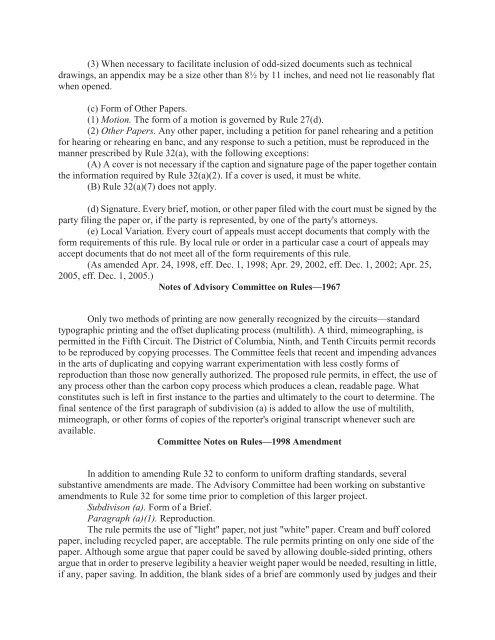Federal Rules of Appellate Procedure 2014-2015, 2014a
Federal Rules of Appellate Procedure 2014-2015, 2014a
Federal Rules of Appellate Procedure 2014-2015, 2014a
You also want an ePaper? Increase the reach of your titles
YUMPU automatically turns print PDFs into web optimized ePapers that Google loves.
(3) When necessary to facilitate inclusion <strong>of</strong> odd-sized documents such as technical<br />
drawings, an appendix may be a size other than 8½ by 11 inches, and need not lie reasonably flat<br />
when opened.<br />
(c) Form <strong>of</strong> Other Papers.<br />
(1) Motion. The form <strong>of</strong> a motion is governed by Rule 27(d).<br />
(2) Other Papers. Any other paper, including a petition for panel rehearing and a petition<br />
for hearing or rehearing en banc, and any response to such a petition, must be reproduced in the<br />
manner prescribed by Rule 32(a), with the following exceptions:<br />
(A) A cover is not necessary if the caption and signature page <strong>of</strong> the paper together contain<br />
the information required by Rule 32(a)(2). If a cover is used, it must be white.<br />
(B) Rule 32(a)(7) does not apply.<br />
(d) Signature. Every brief, motion, or other paper filed with the court must be signed by the<br />
party filing the paper or, if the party is represented, by one <strong>of</strong> the party's attorneys.<br />
(e) Local Variation. Every court <strong>of</strong> appeals must accept documents that comply with the<br />
form requirements <strong>of</strong> this rule. By local rule or order in a particular case a court <strong>of</strong> appeals may<br />
accept documents that do not meet all <strong>of</strong> the form requirements <strong>of</strong> this rule.<br />
(As amended Apr. 24, 1998, eff. Dec. 1, 1998; Apr. 29, 2002, eff. Dec. 1, 2002; Apr. 25,<br />
2005, eff. Dec. 1, 2005.)<br />
Notes <strong>of</strong> Advisory Committee on <strong>Rules</strong>—1967<br />
Only two methods <strong>of</strong> printing are now generally recognized by the circuits—standard<br />
typographic printing and the <strong>of</strong>fset duplicating process (multilith). A third, mimeographing, is<br />
permitted in the Fifth Circuit. The District <strong>of</strong> Columbia, Ninth, and Tenth Circuits permit records<br />
to be reproduced by copying processes. The Committee feels that recent and impending advances<br />
in the arts <strong>of</strong> duplicating and copying warrant experimentation with less costly forms <strong>of</strong><br />
reproduction than those now generally authorized. The proposed rule permits, in effect, the use <strong>of</strong><br />
any process other than the carbon copy process which produces a clean, readable page. What<br />
constitutes such is left in first instance to the parties and ultimately to the court to determine. The<br />
final sentence <strong>of</strong> the first paragraph <strong>of</strong> subdivision (a) is added to allow the use <strong>of</strong> multilith,<br />
mimeograph, or other forms <strong>of</strong> copies <strong>of</strong> the reporter's original transcript whenever such are<br />
available.<br />
Committee Notes on <strong>Rules</strong>—1998 Amendment<br />
In addition to amending Rule 32 to conform to uniform drafting standards, several<br />
substantive amendments are made. The Advisory Committee had been working on substantive<br />
amendments to Rule 32 for some time prior to completion <strong>of</strong> this larger project.<br />
Subdivison (a). Form <strong>of</strong> a Brief.<br />
Paragraph (a)(1). Reproduction.<br />
The rule permits the use <strong>of</strong> "light" paper, not just "white" paper. Cream and buff colored<br />
paper, including recycled paper, are acceptable. The rule permits printing on only one side <strong>of</strong> the<br />
paper. Although some argue that paper could be saved by allowing double-sided printing, others<br />
argue that in order to preserve legibility a heavier weight paper would be needed, resulting in little,<br />
if any, paper saving. In addition, the blank sides <strong>of</strong> a brief are commonly used by judges and their


















